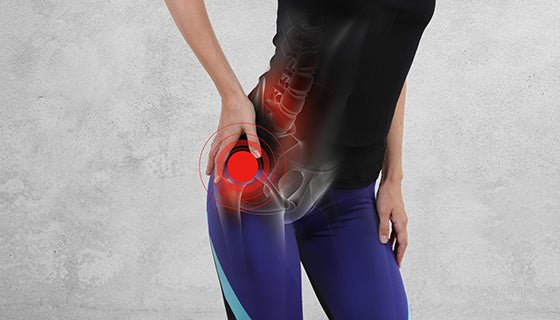WHY DO MY HIPS HURT? THE ANSWER MAY SURPRISE YOU.
The Hip Joint is a Big Deal!
The Importance of the Hip Joint to the Human Body is much the same as the Importance of the "Grand Central Terminal" to the City of New York. You may have heard the term "Everything flows through the hips" - and it is said for good reason!
Major nerves and arteries extending into the lower body pass through the hips, and pinch points for these major nerves are often found in the lower back or the hip. Pinched nerves can happen for many reasons, but soft tissue inflammation due to muscle imbalance, gait issues, and/or overcompensation is one of the major causes.
Hip Pain: Causes and Treatment
The hip joint can withstand repeated motion and a fair amount of wear and tear. This ball-and-socket joint--the body's largest-- fits together in a way that allows for fluid movement.
Whenever you use the hip (for example, by going for a run), a cushion of cartilage helps prevent friction as the hip bone moves in its socket.
Despite its durability, the hip joint isn't indestructible. With age and use, the cartilage can wear down or become damaged. Muscles and tendons in the hip can get overused. Bones in the hip can break during a fall or other injury. Any of these conditions can lead to hip pain.
If your hips are sore, here is a rundown of what might be causing your discomfort and how to get hip pain relief.
- Arthritis.Osteoarthritis and rheumatoid arthritis are among the most common causes of hip pain, especially in older adults. Arthritis leads to inflammation of the hip joint and the breakdown of the cartilage that cushions your hip bones. The pain gradually gets worse. People with arthritis also feel stiffness and have reduced range of motion in the hip. Learn more about hip osteoarthritis.
- Hip fractures. With age, the bones can become weak and brittle. Weakened bones are more likely to break during a fall.
- Bursitis. Bursae are sacs of liquid found between tissues such as bone, muscles, and tendons. They ease the friction from these tissues rubbing together. When bursae get inflamed, they can cause pain. Inflammation of bursae is usually due to repetitive activities that overwork or irritate the hip joint. Learn more about bursitis of the hip.
- Tendinitis. Tendons are the thick bands of tissue that attach bones to muscles. Tendinitis is inflammation or irritation of the tendons. It's usually caused by repetitive stress from overuse. Learn more about tendinitis symptoms.
- Muscle or tendon strain. Repeated activities can put strain on the muscles, tendons, and ligaments that support the hips. When they become inflamed due to overuse, they can cause pain and prevent the hip from working normally.
- Misalignment of Lower Body - Be Aware of Your Posture. A key factor for preventing hip pain is maintaining good posture throughout the day. Your ears, shoulders, hips, and ankles should make a straight line. Having proper alignment goes beyond maintaining a good posture — it can also help prevent long-term pain. Misalignment may impair your range of motion, and severe issues can affect your quality of life (Healthline). Observing your profile picture will tell you if you are letting your head, shoulders, and hips lean forward. This misalignment is the foundation of many health problems including hip pain.
Hip Pain Relief
If your hip pain is caused by a muscle or tendon strain, osteoarthritis, or tendinitis, you can usually relieve it with an over-the-counter pain medication such as acetaminophen or a nonsteroidal anti-inflammatory drug such as ibuprofen.
Rheumatoid arthritis treatments also include prescription anti-inflammatory medications such as corticosteroids, disease-modifying anti-rheumatic drugs (DMARDs) like methotrexate and sulfasalazine, and biologics, which target the immune system.
If you have arthritis, exercising the hip joint with low-impact exercises, stretching, and resistance training can reduce pain and improve joint mobility. For example, swimming is a good non-impact exercise for arthritis. Physical therapy can also help increase your range of motion.
There is another crucial variable that most people don’t take into account when considering how best to achieve proper alignment and posture in turn relieving Hip pain. That is the footwear and arch support that your foot receives. When your feet and arches are supported properly than the rest of your body will be in a better position to be properly aligned and in turn achieving lower body alignment.
Most shoes do not provide proper arch support, and most insoles provide what we like to refer to as static support vs. Dynamic. By static, we mean there is no fluid support through the gait cycle in support of the arch. Static support is primarily the type of support that all orthotic insoles provide, whether they are custom or over-the-counter. To be able to provide Dynamic Arch support would mean providing support underneath the arch throughout the gait cycle, and effectively maintaining alignment throughout the gait cycle.
There is now such an insole called SelectFlex that provides the Dynamic Arch Support. SelectFlex is an entirely new type of dynamic energy returning insole that just won the ISHN Best Protective Footwear category for 2020. SelectFlex insoles use a patented energy returning arch lifting technology called the PowerLift Arch. The PowerLift Arch provides the wearer with 3 energy return levels to support the arch with dynamic alignment with every step. A byproduct of proper alignment will be good posture.







